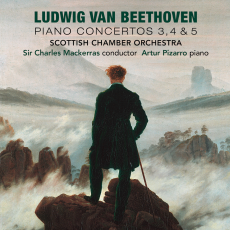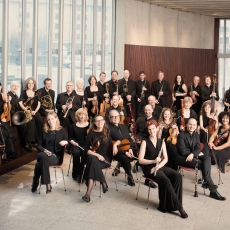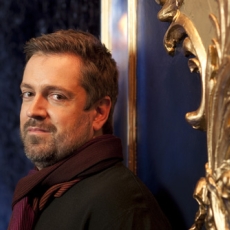Beethoven Piano Concertos 3, 4 & 5 - Audio Video Club of Atlanta
In a specially-priced 2-CD offering from Linn Records, pianist Artur Pizarro joins forces with Sir Charles Mackerras and an augmented Scottish Chamber Orchestra to give us glorious, exalted accounts of Beethoven's Piano Concertos Nos. 3, 4, and 5. Since we've been inundated with Beethoven performances and recordings in the past year or so, and considering that these popular masterworks are among the most oft-recorded of all concertos (with 177, 194, and 212 listings, respectively, in Arkivmusic.com), what do these new accounts have going for them to raise them to the top?
Well, for one there's a real verve and a reveling in the ambiance of gorgeous musical sounds in all these performances that translates into a sense of the joy, the struggle, and the fullness of life. Besides all the equipment of a great young pianist, including a fine sensitivity for matters of rhythm, dynamics and color, Pizarro possesses an unusual rapport with Sir Charles in terms of artistic temperament. That's vital here, because what Beethoven did in these three works was to re-define the relationship between soloist and orchestra. They came across to his contemporaries as strikingly different in that regard from the Classical concerto style of Mozart and of Beethoven himself in his Concertos 1 and 2.
Concerto No. 3 in C Minor, Op. 37 begins with a stormy, extended orchestral introduction that threatens to move into the development section before the abrupt, highly dramatic entrance of the piano. (How dare you start without me?) From the beginning, the writing for the piano is more muscular than in the received classical form, with piano and orchestra striving to out-do each other with vigorous, masculine statements of the first theme, which is then contrasted with a lyric, feminine second subject in a way that would be considered a stroke of genius if it did not seem so intuitive in the light of reflection. That second subject, transformed almost beyond recognition, becomes the theme for the Largo movement, in which the piano takes the center of attention against a reduced orchestra. Pizarro really caresses this magic 9-minute interlude which ambles off into the remote key of E Major. We return to a very decisively stated C Major in a Rondo finale that turns into a triumphant romp for both soloist and orchestra.
In contrast to the stormy opening of its predecessor, Concerto No. 4 in G Major, Op. 58 begins with quietly stated, introspective musing by the piano, which are our first hint that the relationship between soloist and orchestra will be more intimate than we might have expected. The orchestra soon breaks forth in the customary ritornello, but there is a difference as the piano comes in quietly once again following a sudden pause when the orchestra breaks off in mid-phrase. That sets the tone for a work in which dramatic contrast is the order of the day. That goes double for the slow movement in which the piano engages in a gentle, pleading dialog with the implacable string section and eventually subdues it (the analogy of Orpheus calming the Furies with the sweet lyricism of song was quick to suggest itself to Beethoven's audiences). The Rondo vivace finale, in which the trumpets and drums are heard for the first time, bursts forth in a blaze of glory and joyous exuberance, finishing off a work in which the most vivid contrasts have been put across with consummate mastery.
Each of Beethoven's last three piano concertos illustrates one of three basic ways to begin a major work of this sort: starting off in medias res (in the soup) in No. 3, beginning with a slow, quiet introduction in No. 4, and finally, in Concerto No. 5 in E-flat Major, Op. 73, with a striking call to attention in the form of a cadence by the piano based on three massive chords. The main theme is grand and heroic, allowing ample scope for interplay and rivalry between soloist and orchestra and justifying this work's famous nickname, the "Emperor." Considering the complex thematic transformations he puts this opening Allegro movement through, the building blocks, consisting of simple chords, are surprisingly basic. In the "second exposition," a triumphant theme, belonging to the piano alone, provides the pianist the opportunity to shine against a quiet backdrop in which the entire accompaniment, consisting of just two alternating chords, can be played by the tympanist alone (Beethoven can be surprisingly "minimal" when it suits his purpose). The slow movement features a hymn-like melody of great expressive beauty in B Major that is first stated quietly by the strings before the piano follows with its own extraordinary melodic segment. The piano then gives a tantalizing hint of the big melody of the finale, which follows without interruption when a lone bassoon drops a semitone from B to B-flat - simple but highly effective. In the Rondo-Allegro finale, pianist and orchestra have a smashing good time. At least they do in this recording).


